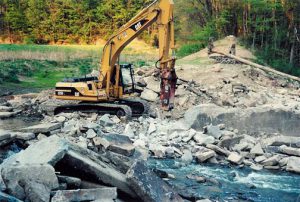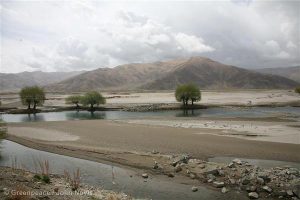It’s rare to see a 30-kilogram Asian carp leap from the waters of the Yangtze these days. On the Mississippi, however, that’s a common site.
Eight varieties of carp – including the bighead, silver carp, black carp and grass carp – come under the single heading “Asian carp” in the US. America started importing them in the 1960s to help clean commercial fish ponds. But they bred rapidly and became a threat to local ecosystems.
On invitation from The Nature Conservancy’s China office, US Asian carp expert Jim Garvey and colleagues visited China recently to look for ways to combat the invasion. Garvey spoke to the Beijing Times about how the Asian carp’s history in the US – and how the country is trying to fight it off.
Beijing Times (BT): Can you tell us about Asian carp in the US? How did they get there?
Jim Garvey (JG): It’s quite complicated. The first type to arrive, in the 1800s, was the common carp, which is widespread in Europe and Asia and eats mainly insects. In 1963 the grass carp was introduced to control the spread of aquatic plants, which it eats. In the 1970s the black, bighead and silver carp, which eat snails and mussels, arrived. And they’ve all done very well.
The American public became aware of the Asian carp about 30 years after they arrived, when they reached the Illinois River. But the gravity of the situation was only realised when they arrived at the economically important waterways of the Great Lakes, and at this point the government was called upon to act. There has been a lot of coverage of this in US media.
The Asian carp are now spreading unchecked in the Mississippi and its tributaries, and may also invade the Great Lakes, which are shared with Canada. The Great Lakes are home to valuable fisheries and are important economically for both countries. We are concerned that the arrival of the Asian carp will reduce the size of those fisheries.
BT: What’s the biggest threat that the Asian carp present to US ecosystems? What have you seen yourself?
JG: Carp generally feed on the bottom of rivers and lakes, which stirs up mud and reduces water quality. The bighead and silver carp eat up algae and plankton, which has a negative impact on local fish species, while the black carp can drive shellfish to extinction.
I first encountered Asian carp in 1998. They had “invaded” the Missouri River and silver carp were leaping out of the water and injuring fishermen. A 10-kilgram silver carp once hit me in the face (though fish bigger than 10 kilograms are rarely seen jumping). Sometimes fishermen wear helmets to protect themselves.
BT: In late 2009, the US government culled large numbers of carp in order to protect the local ecosystems. Was that effective? Do culls work?
JG: In 2009 the government used poison in a small section of the waterways near the Great Lakes, over 100 kilometres away from the lower reaches where the carp are concentrated. That killed off a small number of bighead carp, but also thousands of local fish. As a result, the US government stopped using poison to control Asian carp numbers.
Fishermen are now allowed to catch Asian carp on the lower parts of Chicago’s waterways, and 1,200 tonnes have been caught so far. But these are tiny numbers compared to the fish present in rivers where catching Asian carp isn’t allowed.
My lab research has found that, in this area, the faster the Asian carp are caught, the faster carp swim in from other areas to take their place. I think the best approach would be to encourage catching the carp all over the country, with the government funding fishing and the fish markets.
But in the US people don’t eat carp, and the government doesn’t want to subsidise the market. There’s no market, and there’s been no improvement in Asian carp figures downstream of the Great Lakes.
BT: Could the carp catch be exported? Perhaps to China?
JG: Research by my university, Southern Illinois, and Illinois University, found that carp in the Illinois River contain low levels of pollutants and plenty of nutritious fats and proteins. But currently the US only has three carp-processing plants of any size, and these are facing economic difficulties due to a lack of demand. They mostly process fish meat and oil, or entire fish and fish heads, for export. But shipping costs mean there aren’t any large orders from overseas, and that makes it hard to export carp to China or elsewhere.
BT: The Obama administration sparked international debate when it announced huge investment in a 25-year barrier-building plan to protect the Great Lakes from the Asian carp. What’s your view?
JG: Over the last four years the US government has invested almost US$100 million in research of methods to control the Asian carp. On the Illinois River, a tributary to the Great Lakes, we’ve built a huge electric barrier to keep fish away from the confluence of the two water systems.
That money isn’t actually for a huge barrier. The Great Lakes and the Illinois River are linked by a system of canals. To stop Asian carp in the Illinois from reaching the Great Lakes, the government is looking for a practicable way to close those canals, rather than a barrier to stop the carp. But that would stop water from the Great Lakes reaching Chicago, halt navigation between the Illinois and the lakes, and be hugely expensive.
I think it would stop the Asian carp from reaching the Great Lakes via those canals. But cutting the two water systems off from each other would have costs far above any possible benefit.
BT: What have you gained from your trip to China?
JG: I learned more about the environment of the Asian carp’s habitats on the Yangtze and its tributaries, and about the impact factors such as water flow and temperature have on its breeding. I also learned from Chinese fishermen that, with the right fishing implements, carp numbers can be kept quite low.
In Wuhan we met with experts from the Freshwater Fisheries Research Center, who taught us a lot about how the carp live and breed. In Chongqing, Southern Illinois University and Southwest University signed a partnership on researching the role of the Asian carp in aquaculture, fishing and agriculture. I also learned a lot about how to turn carp into various foodstuffs and products.
The Yangtze is the origin of the Asian carp. This trip to China to study the environment in which it evolved and lives has helped us understand its ecosystem and will inform our efforts to control it in the US.








